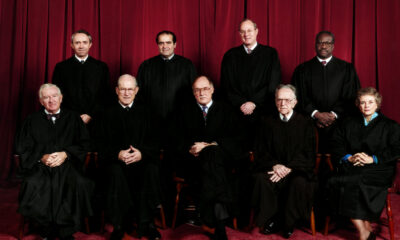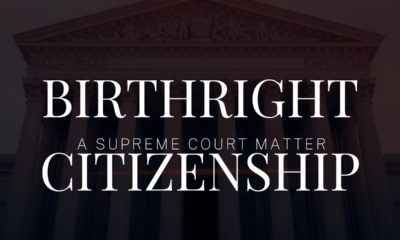Education
If affirmative action ends…
Affirmative action, which has been a part of college admissions for decades, might soon end. The laments speak volumes.
Last fall the Supreme Court heard oral argument on two cases questioning the practice of “affirmative action.” Yesterday one of its strongest legacy media proponents asked how college admissions – and college life – would change without it. But in answering that question for themselves, The New York Times admits what affirmative action proponents have long denied. Which is: the direct beneficiaries of affirmative action displace those better able to do college work.
What is affirmative action?
Affirmative action is, and always has been, a euphemism for reverse discrimination. All institutions, who must admit people to classes with limited space, must discriminate on some basis. They can discriminate on merit – who can do the work and who can’t, and who can do the work better. Or they can discriminate on color, race, athletic ability, “likability,” or in favor of children of alumni.
The basic theory of affirmative action holds that during a certain period in the history of the United States, a “dominant group” deliberately reserved the best education for its own members, and shoved everyone else aside. This is critical race theory, a variant of the critical theory of Antonio Gramsci. According to it, group justice demands shoving aside members of this dominant group in favor of the groups they wronged.
Affirmative action assumes two things:
- All members of the “dominant group” are equally guilty, and all members of other groups are equally aggrieved.
- Merit does not exist. If anyone can’t do college work, the fault might lie with college faculty, but never with the student himself. All persons, by human nature, are equally capable.
The two affirmative action cases
The Supreme Court has two cases “submitted” for decision. A group calling itself Students for Fair Admissions has sued two different schools, alleging discrimination against white and Asian applicants. The two schools are:
- University of North Carolina (Docket No. 21-707) (argument transcript and recording), and
- Harvard University (Docket No. 20-1199) (argument transcript and recording).
Both cases ask one question in common, concerning the case of Grutter v. Bollinger, 539 U.S. 306 (2003). Barbara Grutter, white, applied for admission to University of Michigan Law School. Her white-ness knocked her out of the box. She sued—and lost. The question now becomes: should she have lost?
In addition, the University of North Carolina case asks whether race-neutral admissions are possible. The Harvard case asks flatly whether Title VI of the Civil Rights Act forbids race-conscious admissions policies.
The Supreme Court heard argument in both cases on the same day. Justices Clarence Thomas and Samuel A. Alito clearly lost patience with the arguments of the two sets of respondents. Justice Thomas opened with the Solicitor General of North Carolina in what should be a classic exchange:
Mr. Park, I’ve heard the word “diversity” quite a few times, and I don’t have a clue what it means. It seems to mean everything for everyone.
Precisely. Diversity means whatsoever its proponents say it means, any time they say it. It is a desired resultant distribution of students, nothing more.
The New York Times piece
Yesterday The New York Times published this article by correspondent Stephanie Saul. Its title: “If affirmative action ends, college admissions may [change] forever.” How? Simple – the law would no longer allow colleges and universities to recruit people of certain groups, just to fill slots. But the head of the national group for admissions counselors actually says:
We will see a decline in students of color attending college before we see an increase again. We will be missing an entire generation.
Missing an entire generation? Saul quotes the Director of Admissions for the University of Connecticut as saying some students from “underrepresented” groups “will simply not apply.” And what is an underrepresented group? “Representation” is a subjective judgment, an expression of what one would like to see. But that implies that any given applicant has had members of his group choose him to represent them. In fact, no applicant, and no student, represents anyone but himself. He did not “win” his position by vote or by lot, like Oliver Twist bringing his bowl back to the beadle and pleading,
Please, sir, I want some more.
But thirty-three schools with affirmative action plans briefed the Supreme Court on the two cases at hand. Said they:
The probability of Black applicants receiving offers of admission would drop to half that of white students, and the percentage of Black students matriculating would drop from roughly 7.1 percent of the student body to 2.1 percent.
What do colleges do today?
In that case, say professors, the quality of education would suffer. But no one – not those professors, nor Stephanie Saul and her colleagues – will say how. (And Justices Thomas and Alito weren’t having any of that argument.)
Saul describes the kinds of things colleges do today to bring in non-whites (and, one presumes, non-Asians.) They include:
- Buying lists of prospective applicants, lists that separate them by race and ethnic heritage.
- Expense-paid trips, or “fly-ins,” for applicants.
- Scholarships for which no white nor Asian need apply.
Such practices might already be illegal. Or if they’re legal now, the Court might forbid them in its decisions in the two cases.
So what are colleges doing instead? Some have dropped the requirement for the traditional college admissions tests. This obviously includes the American College and Scholastic Aptitude Tests. Saul suggest they could include Advanced Placement Examinations also, but that is not necessarily the case. An AP test might have its greatest use, not as an admissions test, but as a test to determine whether a new student might be able to handle courses at a higher level than the usual first-year courses. At Yale in 1976, for example, AP tests determined advanced placement (in higher-level courses) and advanced standing (instant course credit that a student could optionally use to get his degree in three years instead of four).
The Legacy and Early Admissions Riddles
Saul did touch on one college practice that, in all fairness, they should never have started. Legacies are students whose parents graduated from a given school. Many admissions committees explicitly prefer legacies to non-legacies. This violates the concept of merit, and CNAV would recommend their abolition in any case. If a “legacy” can’t do the work, he doesn’t belong. Simple as.
Early admissions present a more difficult riddle. In early admissions, a student commits early to a given school, without waiting either to hear from other schools or to explore financial-aid options. SaulThe probability of Black applicants receiving offers of admission would drop to half that of white studentsThe probability of Black applicants receiving offers of admission would drop to half that of white students, and the percentage of Black students matriculating would drop from roughly 7.1 percent of the student body to 2.1 percent,, and the percentage of Black students matriculating would drop from roughly 7.1 percent of the student body to 2.1 percent, assumes that only a well-off student could afford to pledge himself for early admission. That’s not the case. Consider the not-well-off student with a community college within easy commuting or even walking distance. Such a student might indeed “decide early,” knowing that he or she could well afford the tuition. Residency and travel expenses would then disappear.
If they can’t do the work…
But aside from all the above, what does it mean when admissions directors and counselors lament that the composition of their applicant pools and student bodies would change radically? What favors do they really think they’re doing the student whom they admit, only to see him flunk out? Are they not confessing that for nearly sixty years they have denied opportunities to many who, had they admitted them, would have graduated? And all for the sake of admitting students who ended up not graduating?
So when the President of, say, Wesleyan College “worries about what his campus will look like,” he speaks volumes. He has confessed that he knows he has students on his campus who can’t do the work. Or at least, he has students who do the work less well than could others he rejected for the sake of the “look” he wanted.
The one who said they would miss a generation, tellingly didn’t say they would cut off non-whites forever. That’s because the next generation of such students would be better prepared. Such preparation must happen at home, and much earlier in schooling than at college. If the decision these people expect in these cases brings about a renewed emphasis on such preparation, everyone will benefit.
Terry A. Hurlbut has been a student of politics, philosophy, and science for more than 35 years. He is a graduate of Yale College and has served as a physician-level laboratory administrator in a 250-bed community hospital. He also is a serious student of the Bible, is conversant in its two primary original languages, and has followed the creation-science movement closely since 1993.
-

 Civilization2 days ago
Civilization2 days agoDC Pipe Bomb Arrest Raises Questions About Christopher’s Wray’s FBI
-

 Civilization5 days ago
Civilization5 days agoYoo Hoo, VP Vance—Your Character is Showing!
-

 Executive5 days ago
Executive5 days agoThe Last Supper: New York’s Socialist Feast
-

 Guest Columns4 days ago
Guest Columns4 days agoCongressional Leaders See Far Higher Stock Returns Than Peers
-

 Civilization3 days ago
Civilization3 days agoThe Legal Logic Behind U.S. Operations Against Narco-Terrorist Networks
-

 Civilization5 days ago
Civilization5 days agoFacing Facts & Rolling Back Mythologies: The New National Security Strategy
-

 Civilization4 days ago
Civilization4 days agoHow Trump Changed America
-

 Executive3 days ago
Executive3 days agoNewsom’s ‘National Model’ for Homeless Wracked by Fraud















Affirmative Action has not existed since the 1970s. Blacks, as a group, rejected it for quotas and double standards. What people call Affirmative Action today is nothing but double standards and quotas based upon ethnicity and other things that are meaningless for a job. Affirmative Action was created by businesses in the 1950s in California and stopped looking at ethnicity and other items in relation to jobs that had no meaning for a job. What we are dealing with today is NOT Affirmative Action but racial quotas and double standards.